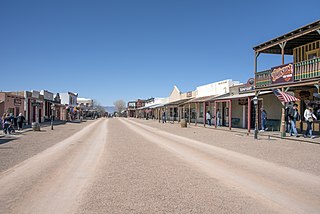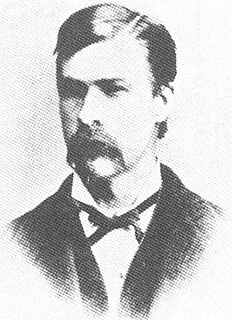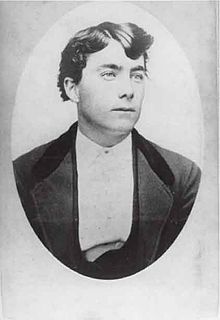
The gunfight at the O.K. Corral was a thirty-second shootout between lawmen led by Virgil Earp and members of a loosely organized group of outlaws called the Cowboys that occurred at about 3:00 p.m. on Wednesday, October 26, 1881, in Tombstone, Arizona Territory, United States. It is generally regarded as the most famous shootout in the history of the American Old West.

Tombstone is a historic city in Cochise County, Arizona, United States, founded in 1877 by prospector Ed Schieffelin in what was then Pima County, Arizona Territory. It became one of the last boomtowns in the American frontier. The town grew significantly into the mid-1880s as the local mines produced $40 to $85 million in silver bullion, the largest productive silver district in Arizona. Its population grew from 100 to around 14,000 in less than seven years. It is best known as the site of the Gunfight at the O.K. Corral and presently draws most of its revenue from tourism. It also houses the highest-rated brewery in the state of Arizona.

Virgil Walter Earp was both deputy U.S. Marshal and Tombstone, Arizona City Marshal when he led his brothers Morgan and Wyatt, and Doc Holliday in a confrontation with outlaw Cowboys at the Gunfight at the O.K. Corral on October 26, 1881. They killed brothers Tom and Frank McLaury and Billy Clanton. All three Earp brothers had been the target of repeated death threats made by the Cowboys who were upset by the Earps' interference in their illegal activities. All four lawmen were charged with murder by Ike Clanton, who had run from the gunfight. During a month-long preliminary hearing, Judge Wells Spicer exonerated the men, concluding they had been performing their duty.

Morgan Seth Earp was an American sheriff and lawman. He served as Tombstone, Arizona's Special Policeman when he helped his brothers Virgil and Wyatt, as well as Doc Holliday, confront the outlaw Cochise County Cowboys in the Gunfight at the O.K. Corral on October 26, 1881. All three Earp brothers had been the target of repeated death threats made by the Cowboys who were upset by the Earps' interference in their illegal activities. The lawmen killed Cowboys Tom and Frank McLaury and Billy Clanton. All four lawmen were charged with murder by Billy's older brother, Ike Clanton, who had run from the gunfight. During a month-long preliminary hearing, Judge Wells Spicer exonerated the men, concluding they had been performing their duty.

William Brocius, better known as Curly Bill Brocius, was a gunman, rustler and an outlaw Cowboy in the Cochise County area of the Arizona Territory during the late 1870s and early 1880s. His name is likely an alias or nickname, and some evidence links him to another outlaw named William "Curly Bill" Bresnaham, who was convicted of an 1878 attempted robbery and murder in El Paso, Texas.

Joseph Isaac Clanton was a member of a loose association of outlaws known as The Cowboys who clashed with lawmen Wyatt, Virgil and Morgan Earp as well as Doc Holliday. On October 26, 1881, Clanton was present at the Gunfight at the O.K. Corral in the boomtown of Tombstone, Arizona Territory but was unarmed and ran from the gunfight, in which his 19-year-old brother Billy was killed.

Tombstone: The Town Too Tough to Die is a 1942 American Western film about the Gunfight at the OK Corral. It is directed by William McGann and stars Richard Dix as Wyatt Earp, Kent Taylor as Doc Holliday and Edgar Buchanan as Curly Bill Brocious. The supporting cast features Rex Bell as Virgil Earp and Victor Jory as Ike Clanton.

John Harris Behan was an American law enforcement officer and politician who served as Sheriff of Cochise County in the Arizona Territory, during the gunfight at the O.K. Corral and was known for his opposition to the Earps. Behan was sheriff of Yavapai County from 1871 to 1873. He was married and had two children, but his wife divorced him, accusing him of consorting with prostitutes. He was elected to the Seventh Arizona Legislative Assembly, representing Yavapai County. In 1881, Wyatt Earp served for about five months as undersheriff of the eastern half of Pima County. When Wyatt resigned, Behan was appointed to fill his place, which included the mining boomtown Tombstone. When Cochise County was formed in February 1881, Behan was appointed as its first sheriff. Tombstone became the new county seat and the location of Behan's office. Sadie Marcus was his mistress, possibly as early as 1875 in Tip Top, Arizona, and certainly from 1880 until she found him in bed with another woman and kicked him out in mid-1881.

The Earp Vendetta Ride was a deadly search by a federal posse led by Deputy U.S. Marshal Wyatt Earp for a loose confederation of outlaw "Cowboys" they believed had ambushed his brothers Virgil and Morgan Earp, maiming the former and killing the latter. The two Earp brothers had been attacked in retaliation for the deaths of three Cowboys in the Gunfight at the O.K. Corral on October 26, 1881. From March 20 to April 15, 1882, the federal posse searched southeast Cochise County, Arizona Territory for the men they believed were responsible for the attacks on Virgil and Morgan. Several suspects had been identified and were charged, but were soon released by the court, owing in some cases to legal technicalities and in others to the strength of alibis provided by Cowboy confederates. Wyatt hoped that the legal system would bring the Cowboys to justice, but after suspects in both ambushes were freed, Wyatt resolved to take matters into his own hands.

John Philip Clum was an Indian agent for the San Carlos Apache Indian Reservation in the Arizona Territory. He implemented a limited form of self-government on the reservation that was so successful that other reservations were closed and their residents moved to San Carlos. Clum later became the first mayor of Tombstone, Arizona Territory, after its incorporation in 1881. He also founded the still-operating The Tombstone Epitaph on May 1, 1880. He later served in various postal service positions across the United States.

Frank C. Stilwell was an outlaw Cowboy who killed at least two men in Cochise County during 1877–82. Both killings were considered to have been self-defense. For four months he was a deputy sheriff in Tombstone, Arizona Territory for Cochise County Sheriff Johnny Behan. Stilwell owned interests in several mines and various businesses, including a saloon, a wholesale liquor business, a stage line, and at his death livery stables in Charleston and Bisbee. He was also a partner in a Bisbee-area saloon with ex-Texas Ranger Pete Spence.

Contention City or Contention is a ghost mining town in Cochise County in the southeastern part of the U.S. state of Arizona. It was occupied from the early-1880s through the late-1880s in what was then known as the Arizona Territory. Only a few foundations now remain of this boomtown which was settled and abandoned with the rise and fall of silver mining in and around the area of Tombstone.

Tom McLaury was an American outlaw. He and his brother Frank owned a ranch outside Tombstone, Arizona, Arizona Territory during the 1880s. He was a member of a group of outlaws Cowboys and cattle rustlers that had ongoing conflicts with lawmen Wyatt, Virgil, and Morgan Earp. The McLaury brothers repeatedly threatened the Earps because they interfered with the Cowboys' illegal activities. On October 26, 1881, Tom and Frank were both killed in the Gunfight at the O.K. Corral in Tombstone, Arizona Territory. The Tombstone shootout was his only gunfight.

William Harrison Clanton was an outlaw Cowboy in Cochise County, Arizona Territory. He, along with his father Newman Clanton and brother Ike Clanton, worked a ranch near the boomtown of Tombstone, Arizona Territory and stole livestock from Mexico and later U.S. ranchers.

The O.K. Corral was a livery and horse corral from 1879 to about 1888 in the mining boomtown of Tombstone, Arizona Territory, in the southwestern United States near the border with Mexico.

The Cochise County Cowboys were a loosely associated group of outlaw cowboys in Pima and Cochise County, Arizona Territory in the late 19th century. The term cowboy had only begun to come into wider usage during the 1870s, and in the place and time, Cowboy was synonymous with rustler. Cattle thieves frequently rode across the border into Mexico and stole cattle from Mexican ranches, which they drove back across the border and sold in the United States. Some modern writers consider them to be one of the first and earliest forms of organized crime syndicates in American history.

Cochise County in southeastern Arizona was the scene of a number of violent conflicts in the 19th-century and early 20th-century American Old West, including between white settlers and Apache Indians, between opposing political and economic factions, and between outlaw gangs and local law enforcement. Cochise County was carved off in 1881 from the easternmost portion of Pima County during a formative period in the American Southwest. The era was characterized by rapidly growing boomtowns, the emergence of large-scale farming and ranching interests, lucrative mining operations, and the development of new technologies in railroading and telecommunications. Complicating the situation was staunch resistance to white settlement from local Native American groups, most notably during the Apache Wars, as well as Cochise County's location on the border with Mexico, which not only threatened international conflict but also presented opportunities for criminal smugglers and cattle rustlers.

The O.K. Corral hearing and aftermath was the direct result of the 30-second Gunfight at the O.K. Corral in Tombstone, Arizona Territory, on October 26, 1881. During that confrontation, Deputy U.S. Marshal and Tombstone Town Marshal Virgil Earp, Assistant Town Marshal Morgan Earp, and temporary deputy marshals Wyatt Earp and Doc Holliday shot and killed Billy Clanton, and Tom and Frank McLaury. Billy's brother Ike, who had repeatedly threatened to kill the Earps for some time, had been present at the gunfight but was unarmed and fled. As permitted by territory law, he filed murder charges against the Earps and Doc Holliday on October 30.

The Ten-Percent Ring was a title given by the newspaper editors of The Tombstone Epitaph in 1881 to Johnny Behan and his friends for stealing about ten percent of the local Tombstone, Arizona taxes in the 1880s. Milt Joyce (1847–1889), owner of the Oriental Saloon and chairman of Cochise County, Arizona supervisors, was also seen as a leader of the Ten Percent Ring. The Tombstone Epitaph was started by John Clum in 1880. The newspaper outlined the corruption charges of Johnny Behan the Cochise County sheriff. When Johnny Behan was the Cochise County sheriff one of his duties was collecting prostitution, gambling, liquor, and theater taxes. As part of his pay, he received 10% of all proceeds collected. There was much talk in the town about the graft political corruption of the sheriff. For this many saw Behan as the head of the Ten Percent Ring and a friend of the outlaw Cochise County Cowboys. Others accused of membership in the ring was Artemus Fay (?–1906), owner of the Tombstone's first newspaper, the Tombstone Weekly Nugget and Harry Wood (1848–1896) a writer for the Weekly Nugget and an under-sheriff of Behan. Along with stealing tax funds, the Ten Percent Ring helped in election fraud and helping the outlaw Cochise County Cowboys. Behan so focused on taxes, that he was very soft on crime. Soon after Behan became sheriff, Virgil Earp was appointed Tombstone city marshal and had his brothers Wyatt Earp and Morgan Earp become special deputy policemen. Behan and the Earps were at conflict as Behan supported the outlaw Clanton and McLaury families. After the Gunfight at the O.K. Corral and the murder of Morgan Earp, Behan did nothing to find the killers of Morgan Earp. Rather than look for Morgan's killers, Behan put out warrants for U.S. marshal Virgil Earp and Wyatt for killing outlaws. On January 31, 1882, Behan was arrested for collecting bills totaling $300 twice, arraigned in front of Justice Stilwell, and discharged due to a technicality. Behan failed to win re-election as sheriff in November of 1882; he would not serve as a peace officer again. Later, he was appointed as the warden of the Yuma Territorial Prison and had various other government jobs until his death in 1912. Milt Joyce departed Tombstone in 1883. On October 10, 1880 Joyce and Doc Holliday had a shoot-out at the Oriental. Joyce died in 1889 at the age of 42 in San Francisco, where he was the owner of the Baldwin Billiard Parlor in 1883 and later the Cafe Royal in San Francisco. Harry M. Woods, a Pennsylvania Infantry Union Veteran, moved to from Tombstone to Nogales, Arizona where he was a tax collector until his death in 1896. After Artemus Fay departed the Weekly Nugget, which burned in the great fire of 1882 and did not re-open, he worked at the Nugget Mine in Dos Cabezas and start a short-lived paper there, the GoNote. After the death of his wife, Fay moved to Flagstaff and started a newspaper there.



















